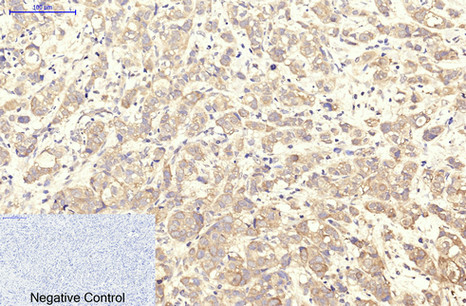CD41 Monoclonal Antibody(Q90)
- 货号:YM3106
- 应用:IHC;IF
- 种属:Human
- 简介:
- >>Rap1 signaling pathway;>>PI3K-Akt signaling pathway;>>Focal adhesion;>>ECM-receptor interaction;>>Platelet activation;>>Neutrophil extracellular trap formation;>>Hematopoietic cell lineage;>>Regulation of actin cytoskeleton;>>Human papillomavirus infection;>>Pathways in cancer;>>Small cell lung cancer;>>Hypertrophic cardiomyopathy;>>Arrhythmogenic right ventricular cardiomyopathy;>>Dilated cardiomyopathy;>>Fluid shear stress and atherosclerosis
- 免疫原:
- Synthetic Peptide of CD41
- 特异性:
- The antibody detects endogenous human CD41/ Intergrin α2b protein.
- 组成:
- PBS, pH 7.4, containing 0.5%BSA, 0.02% sodium azide as Preservative and 50% Glycerol.
- 稀释:
- IHC 1:100. IF 1:50-200
- 纯化工艺:
- The antibody was affinity-purified from mouse ascites by affinity-chromatography using specific immunogen.
- 储存:
- -15°C to -25°C/1 year(Do not lower than -25°C)
- 其他名称:
- ITGA2B;GP2B;ITGAB;Integrin alpha-IIb;GPalpha IIb;GPIIb;Platelet membrane glycoprotein IIb;CD41
- 背景:
- This gene encodes a member of the integrin alpha chain family of proteins. The encoded preproprotein is proteolytically processed to generate light and heavy chains that associate through disulfide linkages to form a subunit of the alpha-IIb/beta-3 integrin cell adhesion receptor. This receptor plays a crucial role in the blood coagulation system, by mediating platelet aggregation. Mutations in this gene are associated with platelet-type bleeding disorders, which are characterized by a failure of platelet aggregation, including Glanzmann thrombasthenia. [provided by RefSeq, Jan 2016],
- 功能:
- disease:Defects in ITGA2B are a cause of Glanzmann thrombasthenia (GT) [MIM:273800]; also known as thrombasthenia of Glanzmann and Naegeli. This autosomal recessive disorder is the most common inherited disease of platelets. GT is characterized by mucocutaneous bleeding of mild-to-moderate severity and the inability of this integrin to recognize macromolecular or synthetic peptide ligands. GT has been classified clinically into types I and II. In type I, platelets show absence of the glycoprotein IIb/beta-3 complexes at their surface and lack fibrinogen and clot retraction capability. In type II, the platelets express the glycoprotein IIb/beta-3 complex at reduced levels (5-20% controls), have detectable amounts of fibrinogen, and have low or moderate clot retraction capability. The platelets of GT 'variants' have normal or near normal (60-100%) expression of dysfunctional receptors.,fun
- 细胞定位:
- Membrane; Single-pass type I membrane protein.
- 组织表达:
- Isoform 1 and isoform 2 are expressed in platelets and megakaryocytes, but not in reticulocytes. Not detected in Jurkat, nor in U937 cell lines (PubMed:2351656). Isoform 3 is expressed in prostate adenocarcinoma, as well as in several erythroleukemia, prostate adenocarcinoma and melanoma cell lines, including PC-3, DU-145, HEL, WM983A, WM983B and WM35. Not detected in platelets, nor in normal prostate (at protein level) (PubMed:9809974).

- Immunohistochemical analysis of paraffin-embedded Human-breast-cancer tissue. 1,CD41 Monoclonal Antibody(Q90) was diluted at 1:200(4°C,overnight). 2, Sodium citrate pH 6.0 was used for antibody retrieval(>98°C,20min). 3,Secondary antibody was diluted at 1:200(room tempeRature, 30min). Negative control was used by secondary antibody only.




